Numerical Simulation of Gas-Solid Two-Phase Erosion for Elbow and Tee Pipe in Gas Field
Abstract
:1. Introduction
2. Numerical Model
2.1. Gas Control Equations
2.2. Turbulence Model
2.3. Discrete Phase Model
2.4. Erosion Modeling
2.5. Model Validation
3. CFD Modeling
3.1. Geometric Model
3.2. Parameter Settings
4. Results and Discussion
4.1. Erosion Analysis of Right Angle/Elbow/Blind Tee
4.2. Erosion Analysis of 1.5D/3D Elbow Erosion
4.3. Erosion Analysis of Straight Pipe Weld/Elbow Weld
5. Conclusions
- (1)
- The maximum erosion rate of the pipe wall is positively nonlinear with the incident velocity and increases linearly with the increase of sand mass flow rate. The blind tee has the most obvious growth rate followed by the erosion rates of 1.5D elbow and 3D elbow, while the maximum erosion rate of the right-angle elbow is the smallest.
- (2)
- The most serious erosion of the blind tee is located in the blind end of the pipe wall. Compared with elbows, the flow field near the blind end of the tee is complicated, and particles will rebound to the upstream, thereby dispersing the severely affected area. However, due to the high energy of the particles hitting the wall, the erosion rate is high at the point where the erosion is most severe. When using blind tees in actual engineering, attention should be paid to the design of the blind end wall thickness, sufficient erosion margin should be considered, and erosion tests should be carried out on the blind end regularly to avoid potential safety hazards.
- (3)
- The most serious erosion area of the right-angle elbow is located outside of the downstream pipe wall. The maximum erosion rate of the inner wall of the elbow tube of 1.5D is greater than that of the 3D elbow as a whole, and the 1.5D elbow is more concentrated in the serious erosion area. Therefore, in the production practice, the elbow with a large curvature radius should be selected to reduce the erosion wear at the elbow.
- (4)
- The maximum erosion position of the straight pipe weld is located in the near-ground part of the weld due to gravity, and the maximum erosion rate of the bend weld is located in the weld on the outside of the inner wall of the bend. Under the same conditions, the erosion rate of the bend weld is much greater than that of the straight pipe weld, and the increasing trend is more obvious with the increase of the incidence speed and mass flow rate of sand particles.
- (5)
- For pipe fittings of the same specification, the maximum erosion rate of elbows with welds is larger than without welds. The weld is a part of the pipeline that is prone to erosion. Therefore, the welding operation must be carried out in strict accordance with the engineering specifications during the construction.
Author Contributions
Funding
Institutional Review Board Statement
Informed Consent Statement
Data Availability Statement
Conflicts of Interest
References
- Hong, B.; Li, X.; Song, S.; Chen, S.; Zhao, C.; Gong, J. Optimal planning and modular infrastructure dynamic allocation for shale gas production. Appl. Energy 2020, 261. [Google Scholar] [CrossRef]
- Peng, S.; Chen, Q.; Shan, C.; Wang, D. Numerical analysis of particle erosion in the rectifying plate system during shale gas extraction. Energy Sci. Eng. 2019, 7, 1838–1851. [Google Scholar] [CrossRef]
- Hong, B.; Li, X.; Li, Y.; Li, Y.; Yu, Y.; Wang, Y.; Gong, J.; Ai, D. Numerical Simulation of Elbow Erosion in Shale Gas Fields under Gas-Solid Two-Phase Flow. Energies 2021, 14, 3804. [Google Scholar] [CrossRef]
- Parsi, M.; Najmi, K.; Najafifard, F.; Hassani, S.; McLaury, B.S.; Shirazi, S.A. A comprehensive review of solid particle erosion modeling for oil and gas wells and pipelines applications. J. Nat. Gas Sci. Eng. 2014, 21, 850–873. [Google Scholar] [CrossRef]
- Hong, B.; Li, X.; Di, G.; Song, S.; Yu, W.; Chen, S.; Li, Y.; Gong, J. An integrated MILP model for optimal planning of multi-period onshore gas field gathering pipeline system. Comput. Ind. Eng. 2020. [Google Scholar] [CrossRef]
- Andrews, D.R. An analysis of solid particle erosion mechanisms. J. Phys. D. Appl. Phys. 1981, 14, 1979–1991. [Google Scholar] [CrossRef]
- Chen, X.; McLaury, B.S.; Shirazi, S.A. A comprehensive procedure to estimate erosion in elbows for gas/liquid/sand multiphase flow. J. Energy Resour. Technol. Trans. ASME 2006, 128, 70–78. [Google Scholar] [CrossRef]
- Kang, R.; Liu, H. An integrated model of predicting sand erosion in elbows for multiphase flows. Powder Technol. 2020, 366, 508–519. [Google Scholar] [CrossRef]
- Farokhipour, A.; Mansoori, Z.; Saffar-Avval, M.; Ahmadi, G. 3D computational modeling of sand erosion in gas-liquid-particle multiphase annular flows in bends. Wear 2020, 450–451, 203241. [Google Scholar] [CrossRef]
- Ferng, Y.M.; Lin, B.H. Predicting the wall thinning engendered by erosion-corrosion using CFD methodology. Nucl. Eng. Des. 2010, 240, 2836–2841. [Google Scholar] [CrossRef]
- Zhu, H.; Lin, Y.; Zeng, D.; Zhou, Y.; Xie, J.; Wu, Y. Numerical analysis of flow erosion on drill pipe in gas drilling. Eng. Fail. Anal. 2012, 22, 83–91. [Google Scholar] [CrossRef]
- Messa, G.V.; Wang, Y.; Negri, M.; Malavasi, S. An improved CFD/experimental combined methodology for the calibration of empirical erosion models. Wear 2021, 476, 203734. [Google Scholar] [CrossRef]
- Alghurabi, A.; Mohyaldinn, M.; Jufar, S.; Younis, O.; Abduljabbar, A.; Azuwan, M. CFD numerical simulation of standalone sand screen erosion due to gas-sand flow. J. Nat. Gas Sci. Eng. 2021, 85, 103706. [Google Scholar] [CrossRef]
- Bilal, F.S.; Sedrez, T.A.; Shirazi, S.A. Experimental and CFD investigations of 45 and 90 degrees bends and various elbow curvature radii effects on solid particle erosion. Wear 2021, 476, 203646. [Google Scholar] [CrossRef]
- Duarte, C.A.R.; de Souza, F.J. Innovative pipe wall design to mitigate elbow erosion: A CFD analysis. Wear 2017, 380–381, 176–190. [Google Scholar] [CrossRef]
- Peng, W.; Cao, X.; Hou, J.; Ma, L.; Wang, P.; Miao, Y. Numerical prediction of solid particle erosion under upward multiphase annular flow in vertical pipe bends. Int. J. Press. Vessel. Pip. 2021, 192, 104427. [Google Scholar] [CrossRef]
- Ejeh, C.J.; Boah, E.A.; Akhabue, G.P.; Onyekperem, C.C.; Anachuna, J.I.; Agyebi, I. Computational fluid dynamic analysis for investigating the influence of pipe curvature on erosion rate prediction during crude oil production. Exp. Comput. Multiph. Flow 2020, 2, 255–272. [Google Scholar] [CrossRef] [Green Version]
- Laín, S.; Sommerfeld, M. Numerical prediction of particle erosion of pipe bends. Adv. Powder Technol. 2019, 30, 366–383. [Google Scholar] [CrossRef]
- Parsi, M.; Agrawal, M.; Srinivasan, V.; Vieira, R.E.; Torres, C.F.; McLaury, B.S.; Shirazi, S.A. CFD simulation of sand particle erosion in gas-dominant multiphase flow. J. Nat. Gas Sci. Eng. 2015, 27, 706–718. [Google Scholar] [CrossRef]
- Ogunsesan, O.A.; Hossain, M.; Iyi, D.; Dhroubi, M.G. CFD Modelling of Pipe Erosion Due to Sand Transport BT. In Numerical Modelling in Engineering; Abdel Wahab, M., Ed.; Springer: Singapore, 2019; pp. 274–289. [Google Scholar]
- Gosman, A.D.; Ionnides, S.I. Aspects of computer simulation of liquid-fuelled combustors. J. Energy 1983, 7, 482–490. [Google Scholar] [CrossRef]
- Haider, A.; Levenspiel, O. Drag coefficient and terminal velocity of spherical and nonspherical particles. Powder Technol. 1989, 58, 63–70. [Google Scholar] [CrossRef]
- Forder, A.; Thew, M.; Harrison, D. A numerical investigation of solid particle erosion experienced within oilfield control valves. Wear 1998, 216, 184–193. [Google Scholar] [CrossRef]
- Vieira, R.E.; Mansouri, A.; McLaury, B.S.; Shirazi, S.A. Experimental and computational study of erosion in elbows due to sand particles in air flow. Powder Technol. 2016, 288, 339–353. [Google Scholar] [CrossRef]
- Liu, P.; Wang, Y.; Yan, F.; Nie, C.; Ouyang, X.; Xu, J.; Gong, J. Effects of Fluid Viscosity and Two-Phase Flow on Performance of ESP. Energies 2020, 13, 5486. [Google Scholar] [CrossRef]

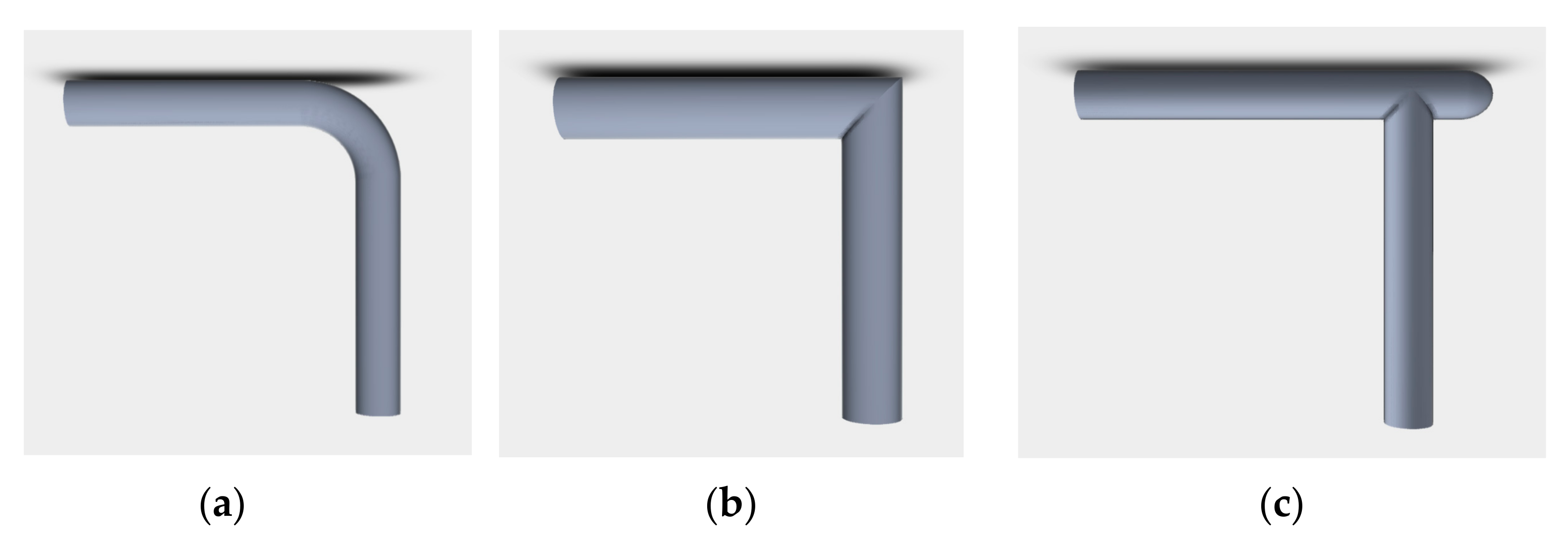
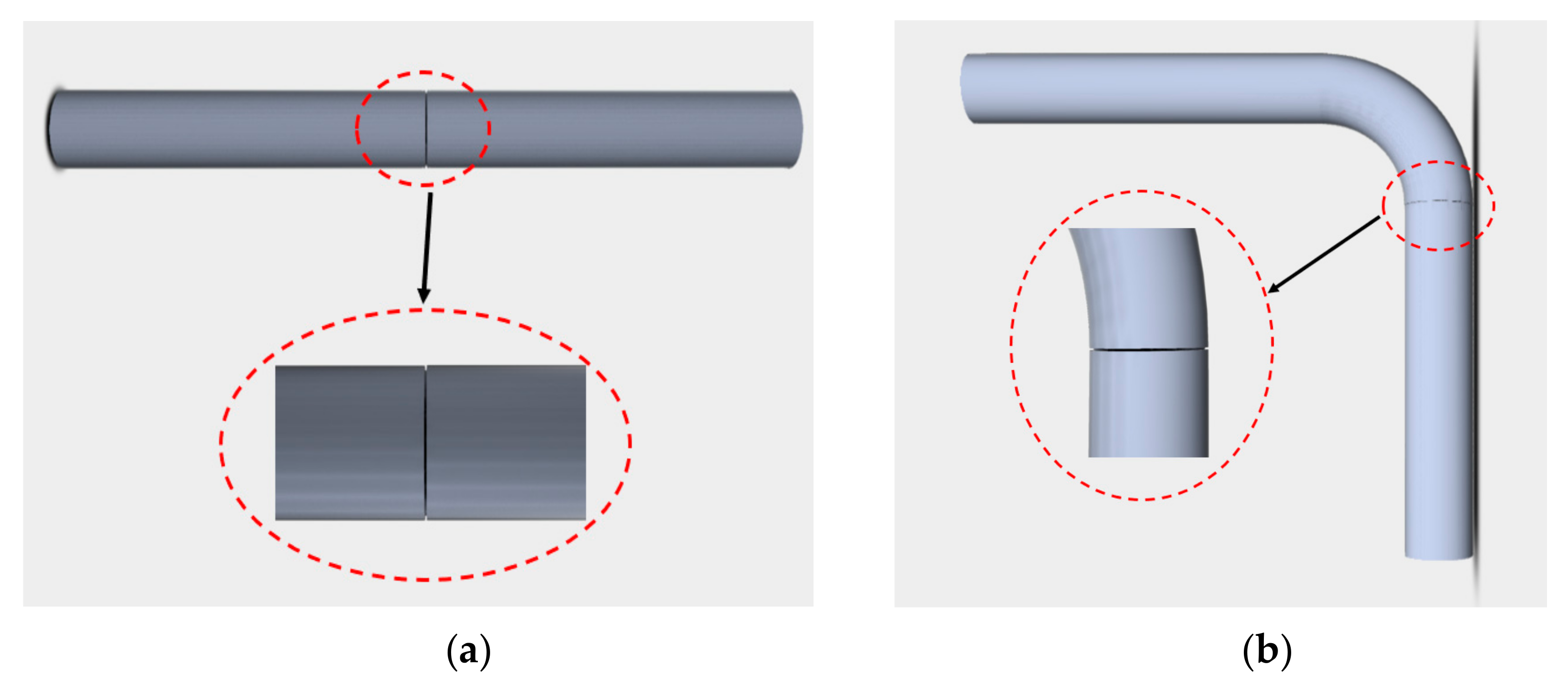
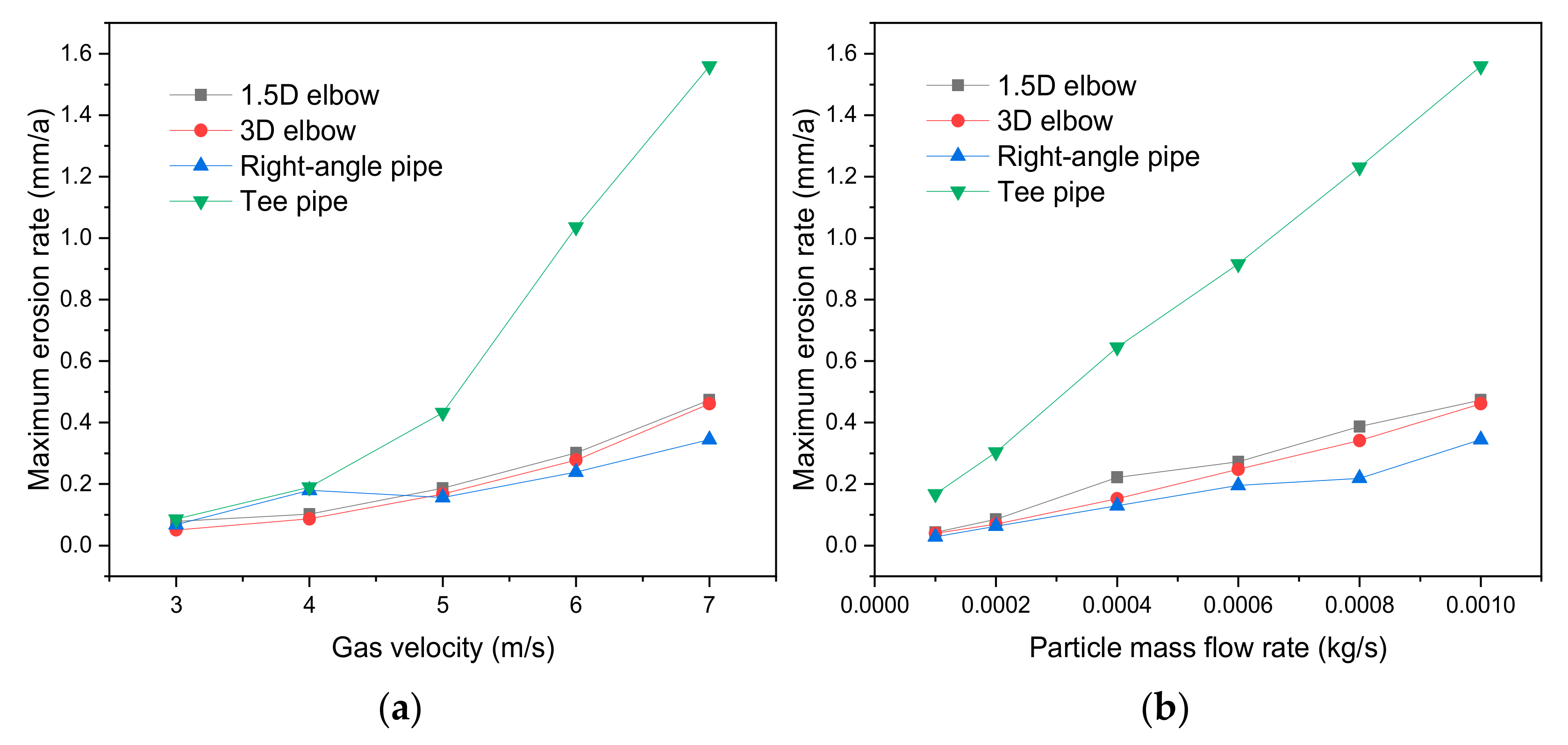
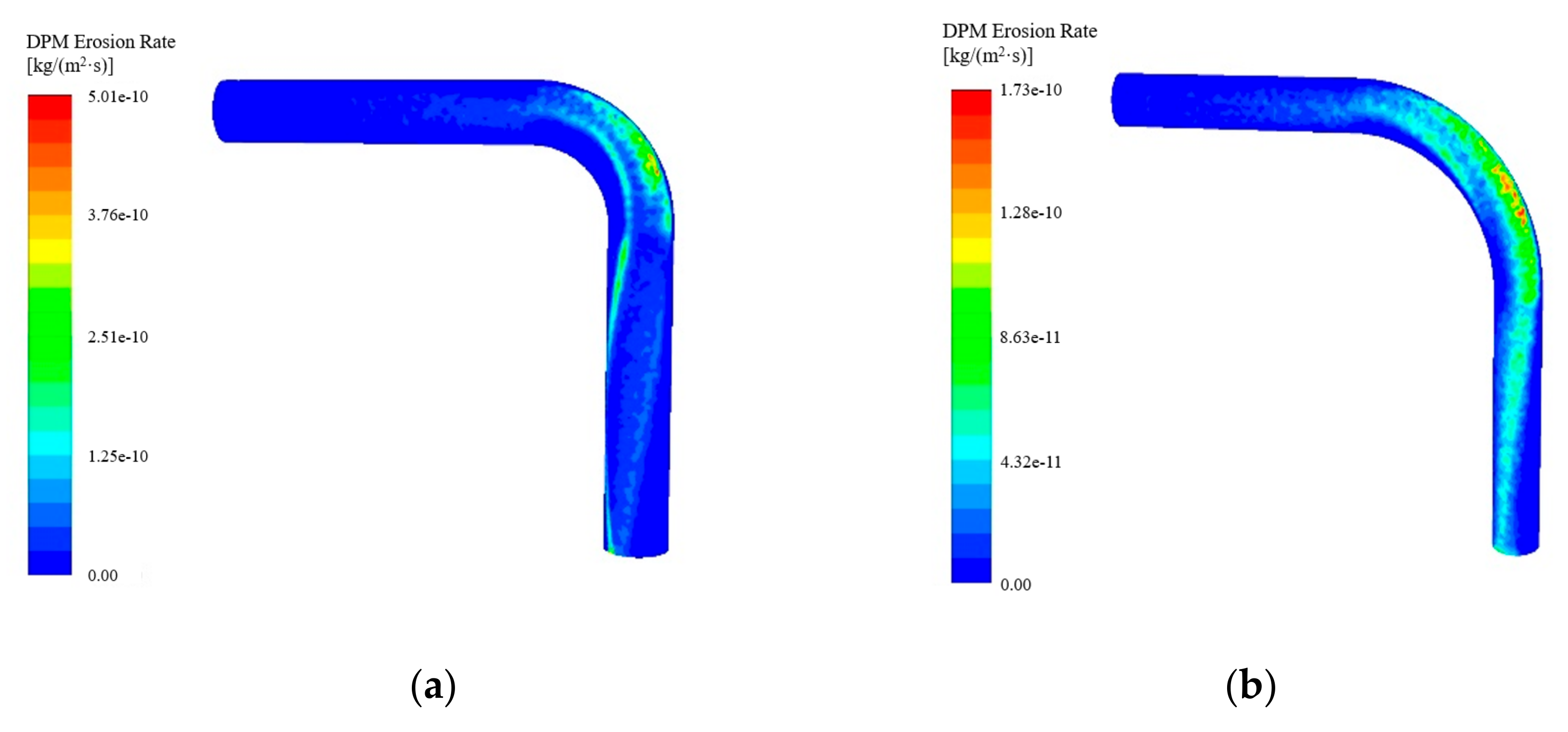

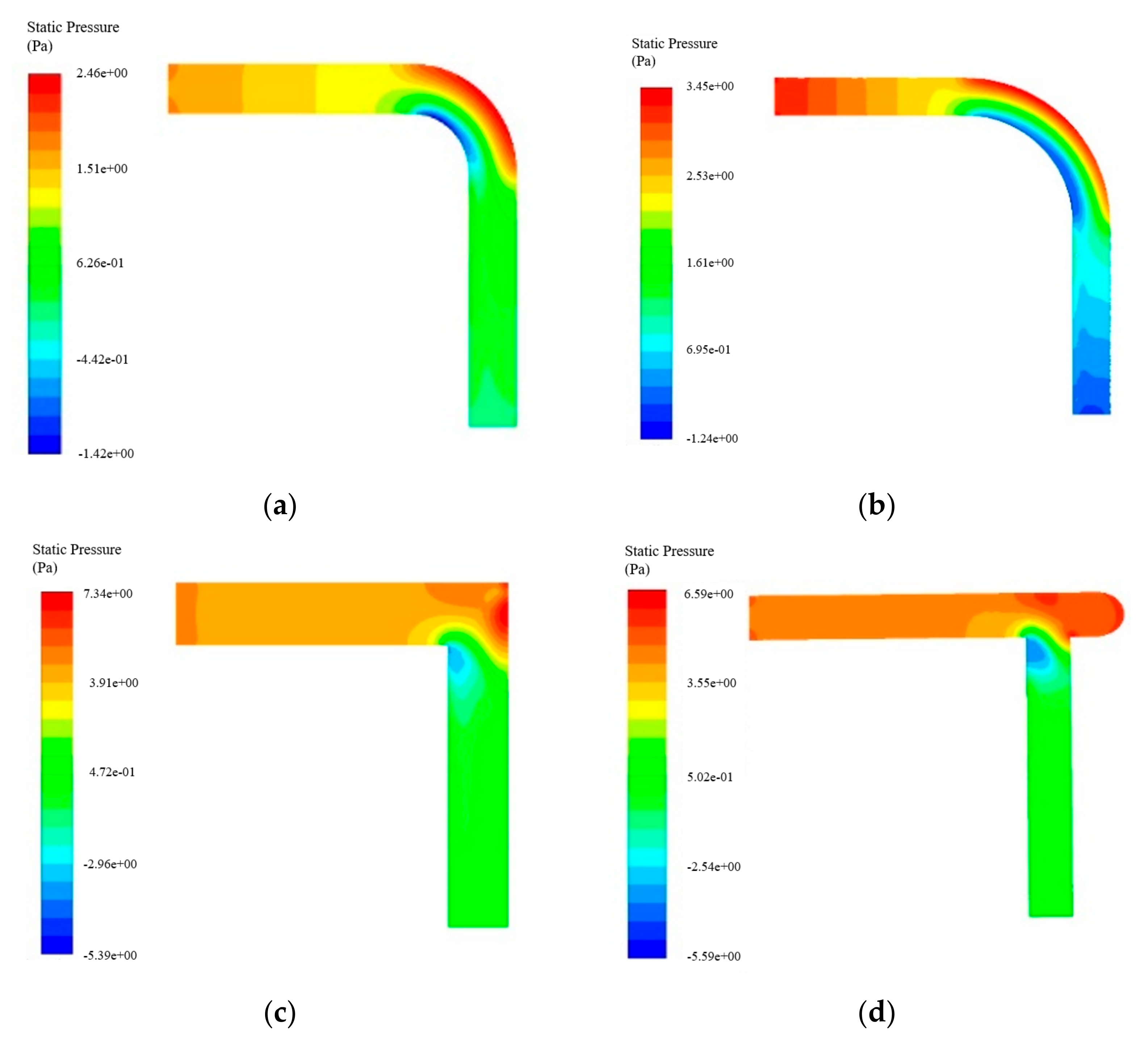
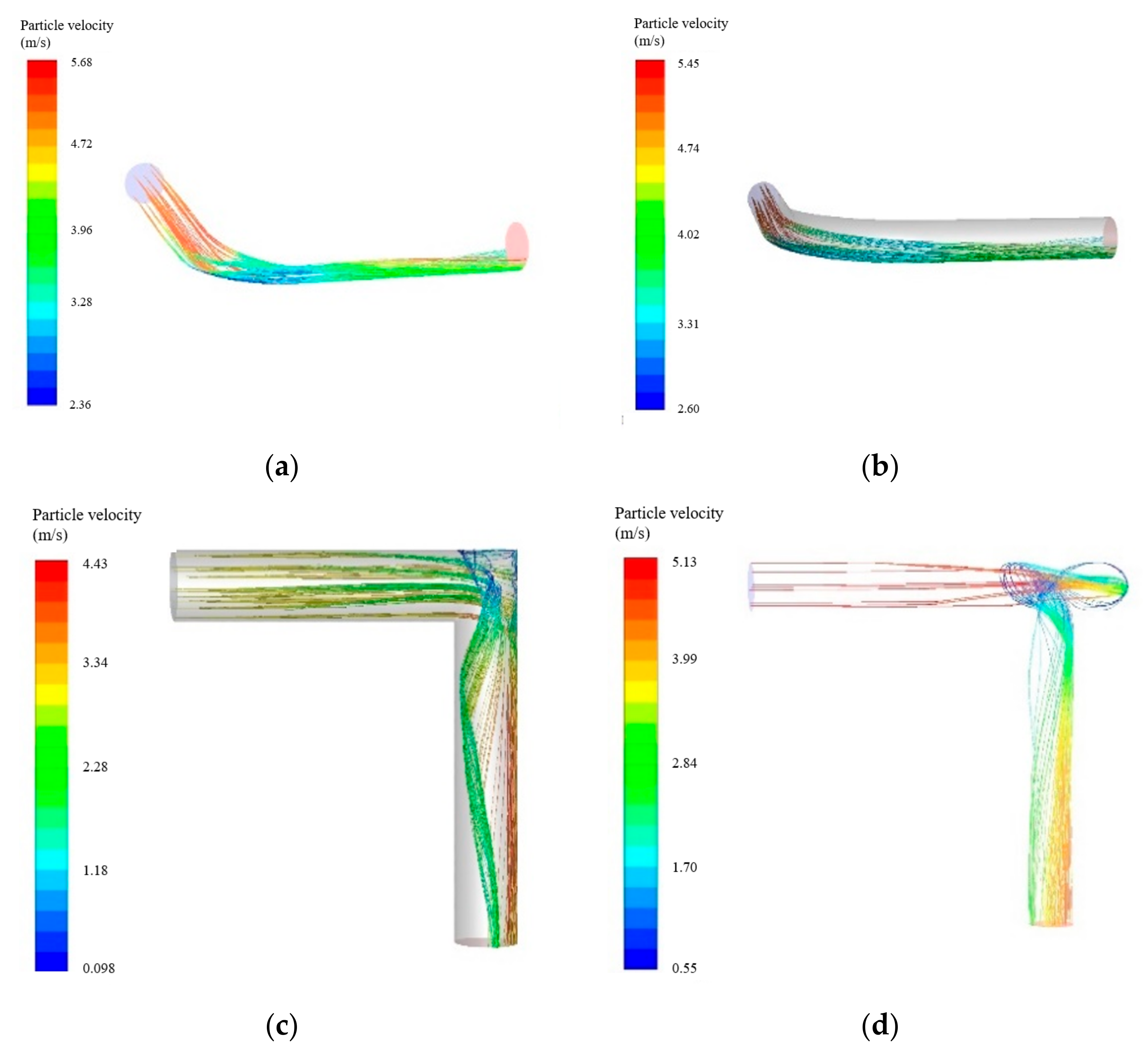
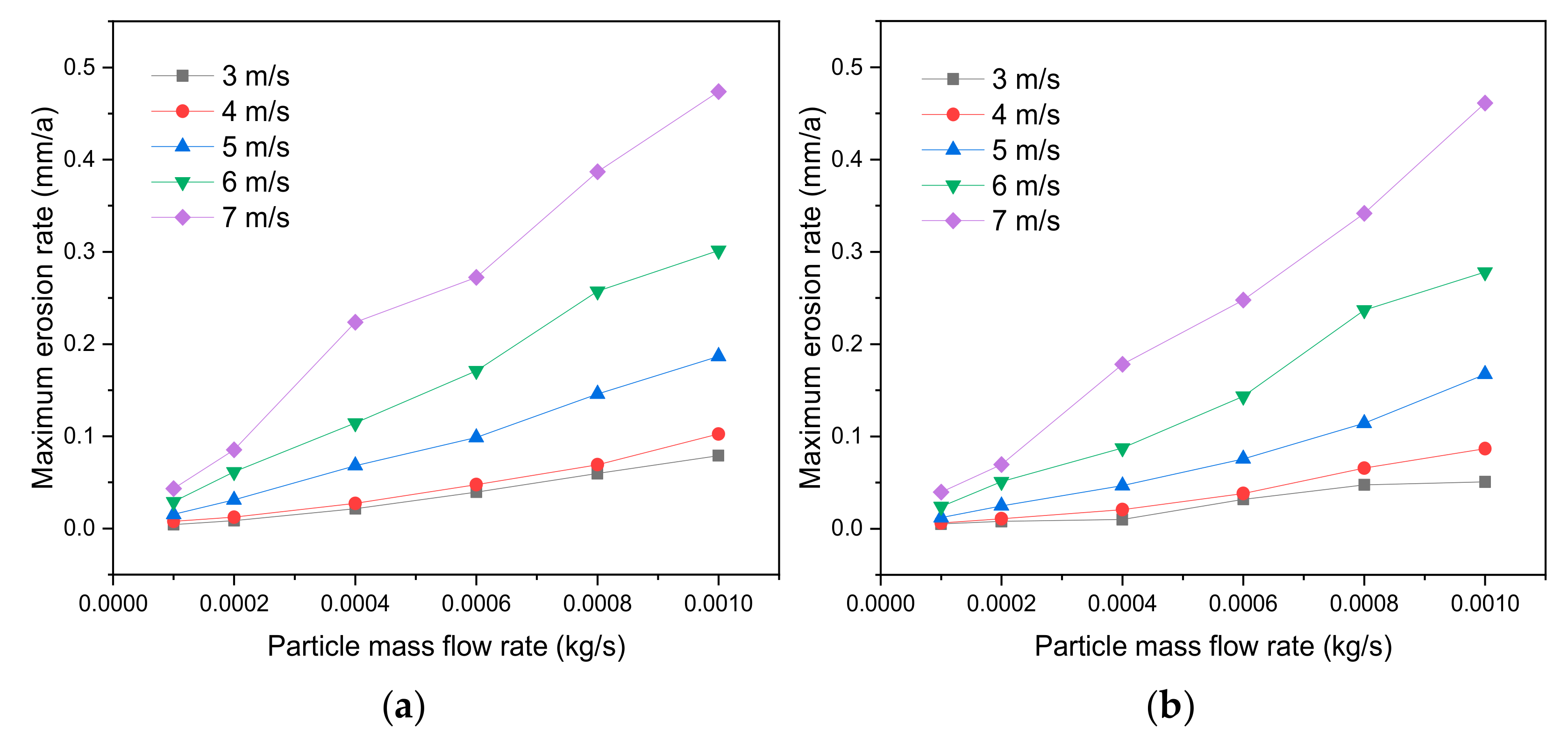

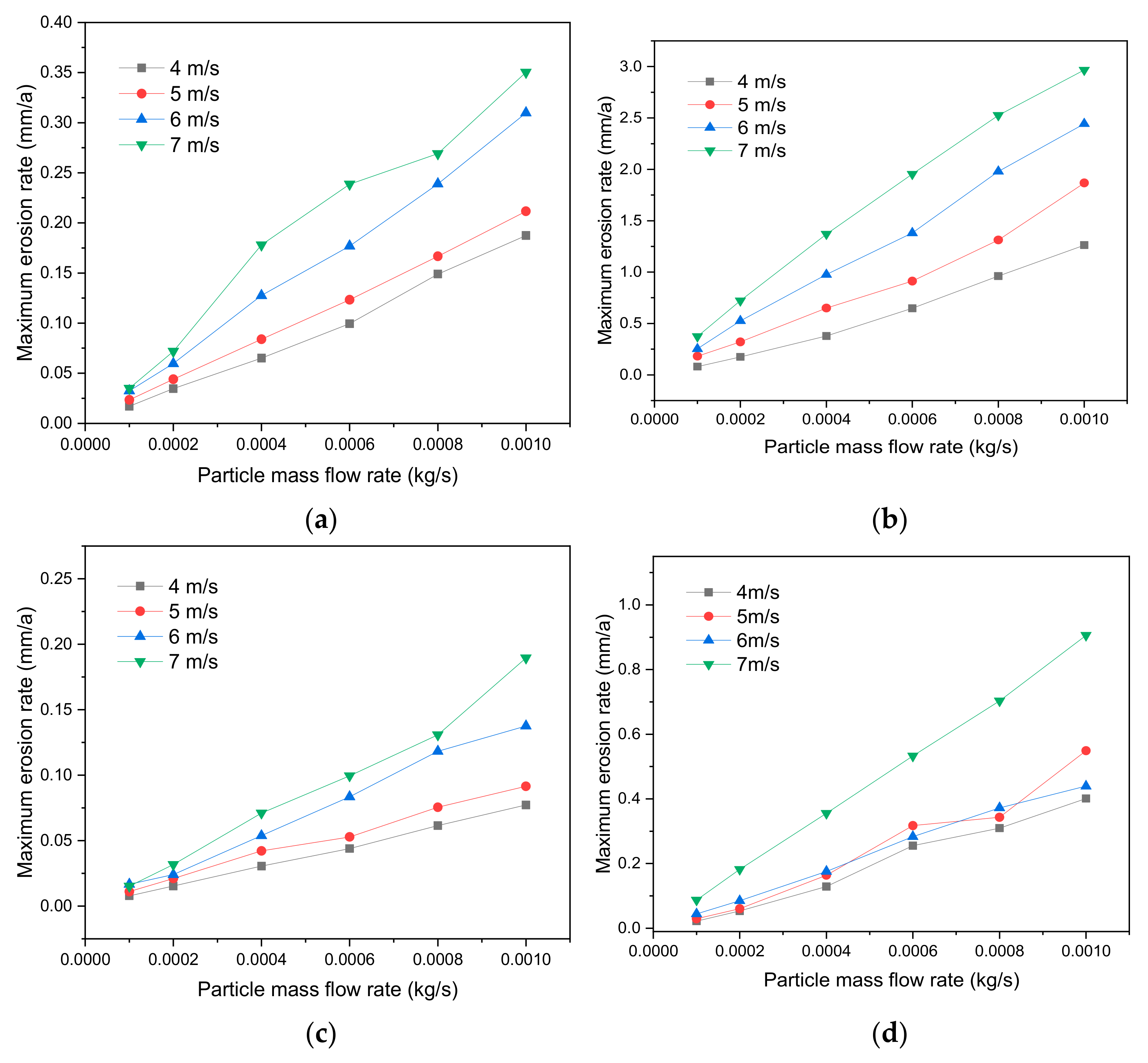

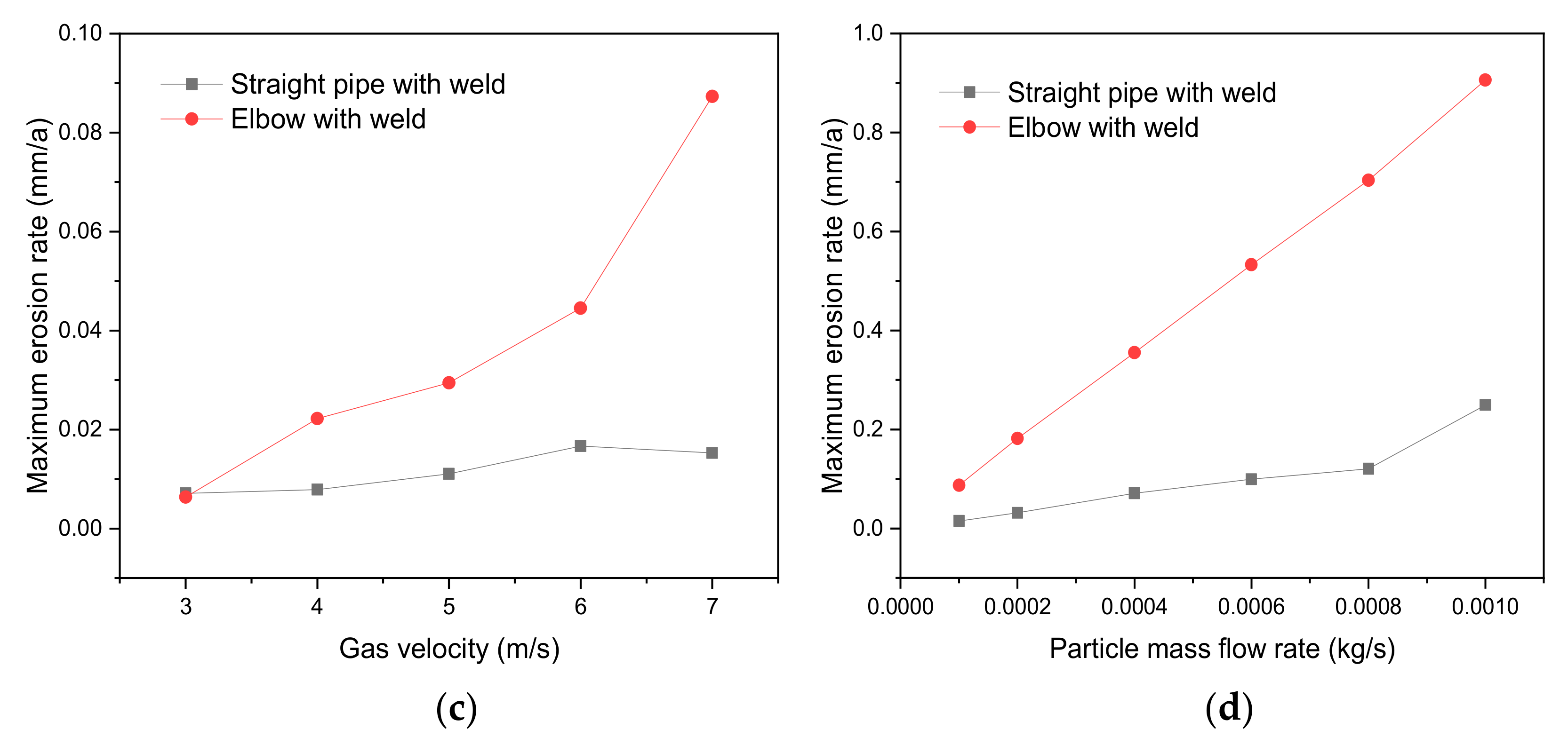



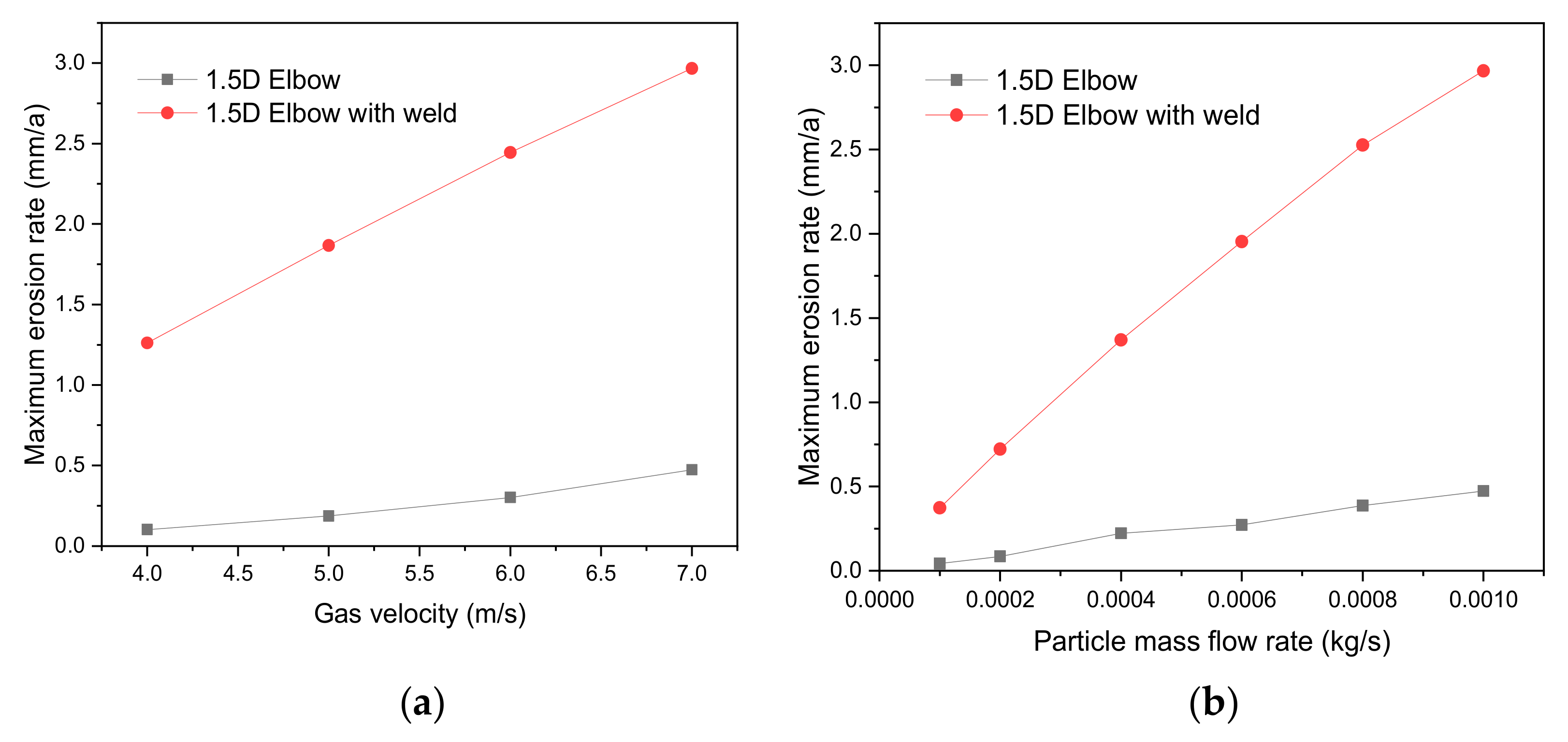
| Point | 1 | 2 | 3 | 4 | 5 |
|---|---|---|---|---|---|
| Angle | 0 | 20 | 30 | 45 | 90 |
| Value | 0 | 0.8 | 1 | 0.5 | 0.4 |
| Influencing Factors | Variable Value |
|---|---|
| Gas flow rate (m/s) | 1/2/3/4/5/6/7 |
| Sand mass flow (kg/s) | 0.001/0.0008/0.0006/0.0004/0.0002/0.0001 |
| Sand particle size (μm) | 60 |
| Inner diameter (mm) | 80/150 |
| Curvature radius of elbow | 1.5D/3D |
| Structure type | 90° elbow/right angle elbow/blind tee |
| Weld type | straight pipe weld/elbow weld |
Publisher’s Note: MDPI stays neutral with regard to jurisdictional claims in published maps and institutional affiliations. |
© 2021 by the authors. Licensee MDPI, Basel, Switzerland. This article is an open access article distributed under the terms and conditions of the Creative Commons Attribution (CC BY) license (https://creativecommons.org/licenses/by/4.0/).
Share and Cite
Hong, B.; Li, Y.; Li, X.; Ji, S.; Yu, Y.; Fan, D.; Qian, Y.; Guo, J.; Gong, J. Numerical Simulation of Gas-Solid Two-Phase Erosion for Elbow and Tee Pipe in Gas Field. Energies 2021, 14, 6609. https://doi.org/10.3390/en14206609
Hong B, Li Y, Li X, Ji S, Yu Y, Fan D, Qian Y, Guo J, Gong J. Numerical Simulation of Gas-Solid Two-Phase Erosion for Elbow and Tee Pipe in Gas Field. Energies. 2021; 14(20):6609. https://doi.org/10.3390/en14206609
Chicago/Turabian StyleHong, Bingyuan, Yanbo Li, Xiaoping Li, Shuaipeng Ji, Yafeng Yu, Di Fan, Yating Qian, Jian Guo, and Jing Gong. 2021. "Numerical Simulation of Gas-Solid Two-Phase Erosion for Elbow and Tee Pipe in Gas Field" Energies 14, no. 20: 6609. https://doi.org/10.3390/en14206609






